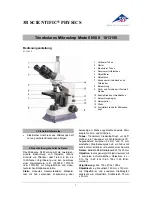
LSM 710 and LSM 780
LEFT TOOL AREA AND HARDWARE CONTROL TOOLS
Systems
Acquisition Tab
Carl Zeiss
02/2010 M60-1-0025
e
103
5.2.19.3
Defining the Detection Parameters
•
Activate the
Channels
tool (Fig. 101).
•
Set the
Pinhole
to one Airy Unit clicking
1 AU
.
−
The pinhole diameter should be so small that
there is still enough variation for the setting
of the Gain (Master) and that sufficient
image information is still available. 1 Airy is a
good value to enable a confocal fluorescence
XY-image to be obtained.
−
A small pinhole diameter will increase the
depth of focus, but reduce the light intensity
received by the PMT photomultiplier (for
reflection mode confocal images start with a
pinhole value of 0.5 Airy Units).
•
Use the
Auto Exposure
button.
−
The system determines the settings for the
Gain (Master) and digital offset to match the
scan speed, pinhole size and laser power.
−
Finally, the system builds up the image.
5.2.19.4
How to Optimize Image Quality
As a rule, the first scanned image is not ideal, since
the settings of the laser and therefore also the
photomultiplier might not match the light output.
More often than not, the screen image is dull and
needs subsequent optimization.
•
Use the lookup table
Range Indicator
(see
section
Dimensions
). This display mode shows
overexposed regions in red and underexposed
regions in blue. Some red and some blue pixels
should be visible to ensure the signal is spread
over the dynamic range of the detector and no
image information is lost.
•
Start a
Continuous
scan and quickly adjust the
laser power, Gain (Master) and offset to set the
image into the dynamic range.
•
Try to lower the impact of laser light onto the
sample. Reduce the laser power and adjust the
gain accordingly.
Fig. 101
Channels tool
Fig.
102
Image displaying bad adjustment of
gain and offset (blue regions are under-
exposed, red regions are overexposed)
















































